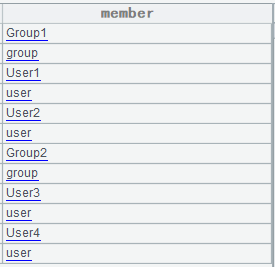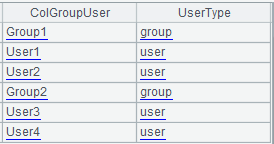Combine Two Columns into One
【Question】
How to move two columns of data to one column data?
I have users that belong to groups. I need to make both data in one column and specify if this is group or user.
Source data in “mytable”:
ColGroup ColUser
Group1 User1
Group1 User2
Group2 User3
Group2 User4
...
Note: The list of groups and users is longer than this simple sample. Each user can belong only to one group (ColUser is PK in table). Groups can have multiple users.
Result of SQL should be:
ColGroupUser UserType
Group1 group
User1 user
User2 user
Group2 group
User3 user
User4 user
...
Note: Start with Group1, then list all users that belong to Group1. In our sample there are User1 and User2. Then move on to display Group2 and all users that belong to Group2, which are User3 and User4 here.
Question: how to write such an SQL to move two columns to one column?
My system: DB2 9.5 Enterprise on Linux
A solution:
SELECT COALESCE(ColGroup, ColUser) AS "ColGroupUser"
, CASE
WHEN GROUPING(ColGroup) = 0 THEN
'group'
ELSE 'user'
END AS "UserType"
FROM grofaty.mytable
GROUP BY
GROUPING SETS(ColGroup, ColUser)
ORDER BY
MAX(ColGroup), GROUPING(ColGroup), MAX(ColUser)
【Answer】
It’s common to display multiple columns of grouped data with one column in report building. Sine SQL doesn’t support ordered sets, we need to create a sequence number field, which makes the code difficult to write and understand. It will become easy if we perform the data combination in esProc SPL (Structured Process Language):
| A |
|
| 1 |
$select * from mytable |
| 2 |
=A1.group(ColGroup) |
| 3 |
=A2.conj([~.ColGroup,"group"]|~.conj([ColUser,"user"])) |
| 4 |
=create(ColGroupUser,UserType).record(A3) |
A1: Retrieve data from mytable.

A2: Group records by ColGroup.
A3: Union members of the sequence to generate a new one with expected members.

A4: Create an empty table sequence and populate A3’s members in order row by row.

esProc is intended to process structured data and can be integrated with a reporting tool or a Java application via JDBC. See How to Call an SPL Script in Java.
SPL Official Website 👉 https://www.scudata.com
SPL Feedback and Help 👉 https://www.reddit.com/r/esProc_SPL
SPL Learning Material 👉 https://c.scudata.com
SPL Source Code and Package 👉 https://github.com/SPLWare/esProc
Discord 👉 https://discord.gg/cFTcUNs7
Youtube 👉 https://www.youtube.com/@esProc_SPL


